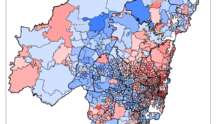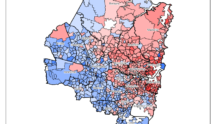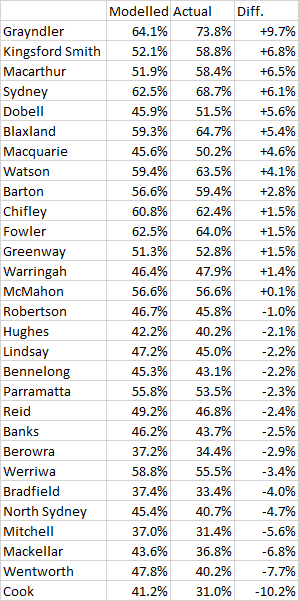In case you were wondering, The Australian reported on Monday that the first Newspoll since the election – indeed, the first poll on voting intention of any kind since the election, unless someone else quickly gets in first – will be published “very shortly”.
In the meantime, I offer what will be the first in a series of posts that probe deep into the results of the federal election region by region, starting with Sydney and some of its immediate surrounds. Below are two colour-coded maps showing the two-party preferred swing at polling booth level, with each booth allocated a geographic catchment area built out of the “mesh blocks” that form the Australian Bureau of Statistics’ smallest unit of geographic analysis (typically encompassing about 30 dwellings). The image on the right encompasses the core of the city, while the second zooms further out. To get a proper look at either, click for an enlarged image.

|

|
In a pattern that will recur throughout this series, there is a clear zone of red in the inner city and the affluent, established eastern suburbs and northern beaches regions, giving way to an ocean of blue in the middle and outer suburbs. The occasional patches of red that break this up are often associated with sophomore surge effects, which played out to the advantage of Mike Freelander, who had no trouble retaining Macarthur (more on that below); Susan Templeman, who held out against a 2.0% swing in Macquarie; and Emma McBride, who survived a 3.3% swing in Dobell (albeit there was little to distinguish this from a 3.1% swing in neighbouring, Liberal-held Robertson).
The second part of our analysis compares the actual two-party results from the election with the results predicted by a linear regression model similar to, but more elaborate than, that presented here shortly after the election. This is based on the correlations observed across the nation between booth-level two-party results and the demography of booths’ catchment areas. The gory details of the model can be found here (the dependent variable being Labor’s two-party preferred percentage). The r-squared values indicate that the model explains 76.5% of the variation in the results – and doesn’t explain another 23.5%. Among the myriad unexplained factors that constitute the latter figure, the personal appeal (or lack thereof) of the sitting member (if any) might be expected to have a considerable bearing.
Such a model can be used to produce estimates that hopefully give some idea as to where the two parties were punching above and below their weight, and where the results were as we might have expected in view of broader trends. The latter more-or-less encompasses Lindsay, which was the only seat in the Sydney region to change hands between Labor and the Coalition (the only other change being Zali Steggall’s win over Tony Abbott in Warringah). The table below shows, progressively, the model’s estimate of Labor’s two-party vote, the actual result, and the difference between the two.
The first thing that leaps out is that the current leaders of both parties did exceptionally well, with their margins evidently being padded out by their substantial personal votes. Beyond that though, patterns get a little harder to discern. The Liberal-versus-independent contests in Warringah and Wentworth appear to have had very different effects on the Coalition’s two-party margins over Labor, which reduced to a remarkably narrow 2.1% as voters turned on Tony Abbott in Warringah, but remained solid at 9.8% in Wentworth, suggesting Dave Sharma may have accumulated a few fans through two recent campaigns and a dignified showing in the wake of the by-election defeat. That there was nonetheless a 7.9% two-party swing to Labor illustrates that he still has a way to go before he matches Malcolm Turnbull on this score.
The modelled result further emphasises the particularly good result Labor had in Macarthur, a seat the Liberals held from 1996 until 2016, when Russell Matheson suffered first an 8.3% reduction in his margin at a redistribution, and then an 11.7% swing to Labor’s Michael Freelander, a local paediatrician. At the May 19 election, the seat defied the national pattern in which outer urban seats that responded had unfavourably to Malcolm Turnbull swept back to the Liberals, with Freelander in fact managing the tiniest of swings in his favour. In addition to Freelander’s apparent popularity, this probably reflected a lack of effort put into the Liberal campaign, as the party narrowly focused on its offensive moves in Lindsay and Macquarie and defensive ones in Gilmore and Reid.

Posters beware. Sprocket with his usual hyperbolic flair cum innuendo reckons that simply linking to comments made by Cameron, entirely relevant for discussion on a blog such as this I would have thought and, with no personal comment of my own is being “gushing”.
I haven’t indicated yet whether I agree with his comments or not.
What a hoot.
sprocket
Then you ought to have no problem with:
However mindless crapping on Richard Di Natale, the Greens approach or strategy by the elected representatives deserves to be called out.
Thankyou, mundo.
I believe Anthony Albanese political strategy has been sound so far. Focusing the message on the economy and jobs, is something could become popular. Especially if a recession occurs and the government implements austerity. Anyway the stage three tax cuts can be cancelled if Labor wins government in 2022.
Also his desire to improve the political discourse in the country and bispartianship will appeal to a lot of voters.
guytaur says:
Saturday, July 20, 2019 at 6:57 pm
Sprocket
When Labor is to the right of a conservative like Dr Phelps it’s not the centre that Labor is at.
_______________________________________
Is that the Dr Phelps who lost her seat at the last election? Asking for a friend.
https://www.bloomberg.com/news/articles/2019-07-18/warren-declares-war-on-private-equity-vampires-in-2020-plan
Tristo:
[‘Also his desire to improve the political discourse in the country and bispartianship will appeal to a lot of voters.’]
Really! The Tories don’t do bipartisanship. They go in lieu for the LCD – political (Goebell’s) analysis 101.
Labor needs to desperately demarcate.
Tristo
Both Rudd and Obama got suckered into the ‘bipartisan’ healing thang and in reply both got a Liverpool kiss and a kick in the groin from the ‘Opposition’. To the public it will be presented by the ‘demented plutocrat’ owned MSM as proof of Scrott’s ascendancy.
Outside of the typically clueless CPG reporting, there is little evidence of this.
sprocket_ @ #1447 Saturday, July 20th, 2019 – 6:59 pm
Hey sprocket. Once you can learn to use apostrophes to a senior primary school level, I might listen to your mindless partisanship.
https://www.theguardian.com/media/2019/jul/20/george-calombaris-good-weekend-editor-laments-angelic-cover-picture-of-disgraced-chef
Not as much as I lament still subscribing to the SMH.
@Mavis Davis
Of course the Coalition is not interested in bipartisanship (expect when it suits them). So Labor can’t be blamed if Albanese strategy is rebuffed by the Coalition.
Anyway I Albanese as the Prime Minister we need to save the nation’s soul and restore people’s trust in our politicians. Also he wants to follow forge a consensus for the country as a whole, which is sorely needed. Anyway Labor can afford to lose some votes and even seats to the Greens in the inner city electorates. As long as they win bucketloads of votes and seats. In the outer suburbs of our major cities and the provincal cities.
adrian:
[‘Hey sprocket. Once you can learn to use apostrophes to a senior primary school level, I might listen to your mindless partisanship.’]
Please stop being a pedantic dickhead.
poroti @ #1457 Saturday, July 20th, 2019 – 7:45 pm
Is there a policy area that has a major point of difference now …?
Tristo:
With respect, whom we have “leading” this country is a relatively young man who believes the world is some 6,000 years old. On that only, he should be disqualified from high office – the man’s a fruitcake. Albanese, on his performance thus far, will not lead Labor from the wilderness; indeed, he seems like he’ll take us further into the abyss. I go back a long way. I’ve never witnessed a more parlous state of affairs. To think in ’72 Gough held such promise, only to be gutted by the establishment.
@Mavis Davis
The Morrison government won, mainly due to exploiting people’s anxiety over Labor’s tax policies. Since Labor is very likely going to dump the negative hearing and franking dividend changes. Along with other cleaning the barnacles off the boat, the Coalition’s scare campaign are going to have much less effect in 2023
Given in 2022 I predict we will in an economic depression as bad as the one in the 1930s. The Coalition’s reputation as being superior managers of the economy will be totally destroyed. Also if the government goes for austerity and Labor promises a huge stimulus to get the economy growing again. That is going to appeal to many voters.
One of the mildly amusing ‘points’ that Peg has been repeating recently on Bludger is that Greens membership is surging in her ‘non inner city’ branch.
Bless. Although, as Peg keeps reminding me I’m no mind reader, I suspect she repeats these kind of statements to rebut the proposition that the Greens are no mere inner city vanity project who live in enclaves behind Melbourne’s Great Wall of Quinoa.
I also suspect that she wants it known that therefore all Labor needs to do is go full vivid Green in its policy offering and virtue posturing to win back similar ‘non inner city’ suburbs: ie. “First we take Box Hill, then Strathpine, Coolbulture, Logan, Greenmore Park, Strathfield, etc will be a cinch. Obviously”.
Of course the AEC classifies Pegs hood in Chisholm as “Inner Metropolitan” and while I don’t doubt for a second that Peg’s branch is surging; really really surging … the melancholy fact is that in terms of actual votes, there really is little evidence of a Greens surge. In fact, just two months ago at the national opinion poll the Greens ‘surge’ in Chisholm was limited to 0.3%, with the Greens now polling 11.84%. Congratulations.
Labor’s vote ‘collapsed’ in Chisholm by 0.39%, and although it wasn’t enough bad ole Labor did get a 2.34% 2PP swing to it …
The Liberals suffered a 3.71% swing against it on primaries but held on.
Insofar as positive swings were concerned the melancholy fact is that the voters of Chisholm preferred to swing to an independent candidate, Democratic Labour, Justice and United Australia over either the Greens and Labor. The preferences from these minors got Gladys Liu elected. How good is that? I wonder how closely the policy positions of the parties that the swinging voters went for reflects the Greens? Not a lot at an educated guess.
I reckon Peg’s surge is just Wunderwaffe for two reasons: her inner metropolitan Melbourne seat is really not reflective of the vast swathes of outer rim suburbs and regional centres where the vote non reactionary, non conservative politics has collapsed, and secondly additional branch members does not in any way reflect greater political support in the broader community, as measured by the metric of actual votes in elections.
Who classifies Box Hill as inner city? It’s a middle ring suburb.
nath @ #1467 Saturday, July 20th, 2019 – 8:48 pm
It’s not even close to inner-city.
Tristo:
I admire your optimism, albeit it’s based on a downturn in the economy, which would be catastrophic for the working-class. A far better result would be a leader, of the measure of an FDR, who brought the US out of the depression by dint of his charismatic leadership. I don’t see any on either side of the divide who measures up. Do you?
Box Hill hardly melbourne’s Equivalent of Penrith, Logan, Strathpine or Coolbuture though is it naff. Arguably, similar to suburbs like Burwood, Strathfield and Five Dock that comprise Reid in Sydney. These days, given the sprawl of both Melbourne and Sydney definitely considered ‘inner metropolitan’.
Like Reid, Chisholm seems to swing between Labor and Liberals every decade or so.
AE
So many words focussing on me. So sweet.
Anything to say about Doug Cameron’s comments?
I never liked Doug much. Nothing has changed.
Penrith, Logan, Strathpine or Coolbuture
_______________
I don’t understand the words coming out of your NSW mouth.
The AEC classifying Chisholm as ‘inner metro’ is probably more to do with the limited categories in use by the AEC.
adrian @ #1458 Saturday, July 20th, 2019 – 7:46 pm
People like to have a real choice between two differing manifestos.
Albanese and Marles have zero chance of beating the LibNats at their own game.
“I don’t understand the words coming out of your NSW mouth.”
Far enough. I’d suggest that upon reflection neither do your fellow Melbourians Julia Gillard, Bill Shorten and Richard Marles etc.
That might hold something of. Key to explaining the omnishambles that is Australian politics over the past decade.
@Mavis Davis
I am pretty confident such a economic downturn will occur world wide in 2020s.
Anyway, comparing Sydney and Melbourne is like comparing a pile of dog shit to a sophisticated European type city with fucking trams.
Andrew_Earlwood @ #1472 Saturday, July 20th, 2019 – 8:56 pm
Too combative ..?
Should’ve ‘worked with the Govt’ more ..?
Tristo:
Who really knows?
Anyway, thanks for the civil exchange. With that, I’m pulling a Pepys.
Ask anyone to name inner city suburbs, they would come up with Melbourne, Kensington, Carlton Brunswick, Parkville, Port Melbourne, South Yarra,
Prahran, etc…..Box Hill, Blackburn Burwood, etc would not come up.
“The AEC classifying Chisholm as ‘inner metro’ is probably more to do with the limited categories in use by the AEC.”
As a Sydneysider I have difficulty orientating myself with Melbourne geography I confess. Having the city wrap around a fairly large body of water that is Port Phillip Bay and having a beautiful Green belt – the Dandenong ranges in the middle does make is somewhat challenging for an outsider such as myself. However, consulting google maps and the AEC maps it does seem that there are at least two further belts of suburbs that radiate out from the CBD beyond the centre of Chisholm.
I suppose it’s a bit like Ashfield in Sydney: 110 years ago the home of the Western Suburbs Football Club (Rugby League). Since then metropolitan Sydney quickly joined with the satellite settlement of Parramatta and then has sprawled out into the Blue mountains. Now Ashfield is definitely considered ‘inner west’ but it neighbours Five Dock, BURWOOD and is only a couple of km away from Strathfield. There are another 50km of the burbs heading west before one gets to Warrimoo and the Blue Mountains proper.
AE
“I never liked Doug much. Nothing has changed”
Too much of a trot? lol
You could call Box Hill as the end of the ‘inner east’, but that’s all I’m willing to concede 🙂
This pile of dog shit?
https://images.app.goo.gl/kUVYBYwHAhD1barU9
Anyway, I usually shop at Mailing Road in more salubrious environs. 🙂
Andrew_Earlwood
says:
Saturday, July 20, 2019 at 9:10 pm
This pile of dog shit?
________________
All you got is that harbour. 🙂
We got culture coming out of our asses.
Draw a line from Elwood to Hawthorn to Brunswick to Flemington and down to Williamstown and that’s your inner city.
Pegarex: I (and the AEC) said “inner metropolitan” not “inner city”.
This is but a minor point of my original post, BTW. As you know and as you assiduously avoid addressing the main points. Obviously …
Rex Douglas
says:
Saturday, July 20, 2019 at 9:15 pm
Draw a line from Elwood to Hawthorn to Brunswick to Flemington and down to Williamstown and that’s your inner city.
_____________________
yep.
https://www.abc.net.au/news/2019-07-20/silence-speaks-volumes-trumps-america-and-home/11326566
AE
“….I confess….”
Ooooh, my curiosity is piqued. Any more confessions forthcoming?
Boerwar says:
Saturday, July 20, 2019 at 1:35 pm
Considering they don’t have Australian citizenship, this is not relevant to the debate.
It seems you don’t even understand the issue and yet you have such a strong opinion about it.
“We got culture coming out of our asses.”
That’s treatable these days. Unless you picked up that bug that seems to be decimating Melbournians at an increasing and alarming rate …
“Ooooh, my curiosity is piqued. Any more confessions forthcoming?”
I like a good confession. Shocking!
Andrew_Earlwood
says:
That’s treatable these days. Unless you picked up that bug that seems to be decimating Melbournians at an increasing and alarming rate …
_____________________________
That’s a serious public health emergency and nothing to joke about.
AE
Shucks, that was boring. Something more titillating would have been more entertaining.
“All you got is that harbour. ”
And the beaches. Beaches upon beaches.
And parks. Oodles of beautiful parklands.
The Australian Opera Company.
The Brandenburg orchestra.
Coffee in Summer Hill Village on a sunny winter’s day. Or at several dozen other quaint sun traps around town …
A few other amusements …
Andrew_Earlwood @ #1499 Saturday, July 20th, 2019 – 9:29 pm
Alan Jones
Gerry Harvey
…